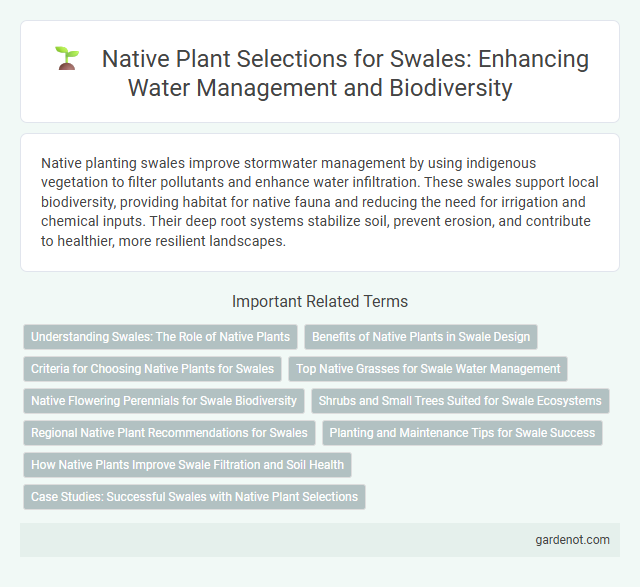Native planting swales improve stormwater management by using indigenous vegetation to filter pollutants and enhance water infiltration. These swales support local biodiversity, providing habitat for native fauna and reducing the need for irrigation and chemical inputs. Their deep root systems stabilize soil, prevent erosion, and contribute to healthier, more resilient landscapes.
Understanding Swales: The Role of Native Plants
Native planting swales enhance stormwater management by using deep-rooted indigenous plants that improve soil infiltration and reduce erosion. These vegetation systems support local biodiversity, provide habitat for pollinators, and help filter pollutants from runoff, thereby improving water quality. Integrating native plants in swales ensures resilience to local climate conditions and promotes sustainable landscape practices.
Benefits of Native Plants in Swale Design
Native plants in swale design enhance water retention and improve soil infiltration by adapting to local climate and soil conditions, reducing erosion effectively. These plants support biodiversity by providing habitat and food sources for native wildlife, including pollinators crucial for ecosystem health. Their deep root systems promote groundwater recharge while minimizing the need for supplemental irrigation and chemical fertilizers.
Criteria for Choosing Native Plants for Swales
Native plants for swales should be selected based on their deep root systems that enhance soil infiltration and stability. Species must tolerate periodic inundation and drought to thrive in fluctuating moisture conditions typical of swales. Prioritizing local native plants that support biodiversity and require minimal maintenance ensures ecological resilience and water quality improvement.
Top Native Grasses for Swale Water Management
Top native grasses for swale water management include Switchgrass (Panicum virgatum), Big Bluestem (Andropogon gerardii), and Little Bluestem (Schizachyrium scoparium) due to their deep root systems that enhance soil permeability and reduce erosion. These grasses efficiently absorb runoff, increase water infiltration, and improve nutrient uptake, making them ideal for native planting in swales. Incorporating native grasses supports local biodiversity while stabilizing swale banks and optimizing water retention in sustainable landscape design.
Native Flowering Perennials for Swale Biodiversity
Native flowering perennials such as Echinacea purpurea, Asclepias tuberosa, and Rudbeckia hirta play a crucial role in enhancing swale biodiversity by supporting pollinators like bees and butterflies. These plants contribute to soil stabilization, water filtration, and provide habitat for local wildlife while requiring minimal maintenance due to their adaptation to regional conditions. Incorporating a diverse mix of native perennials in swale design promotes ecological balance and resilience against invasive species.
Shrubs and Small Trees Suited for Swale Ecosystems
Native shrubs and small trees thrive in swale ecosystems by enhancing water absorption and supporting local biodiversity. Species such as Salix nigra (black willow), Cornus sericea (red osier dogwood), and Cephalanthus occidentalis (buttonbush) are well-adapted to wet, seasonally saturated soils typical of swales. These plants improve soil stability, provide wildlife habitat, and contribute to natural water filtration within the swale environment.
Regional Native Plant Recommendations for Swales
Regional native plant recommendations for swales prioritize species adapted to local hydrological conditions, enhancing water infiltration and pollutant filtration. For example, in the Pacific Northwest, selecting sedges (Carex spp.), rushes (Juncus spp.), and native grasses like blue wildrye (Elymus glaucus) supports swale functionality. Incorporating deep-rooted perennials such as goldenrod (Solidago spp.) and native wildflowers improves soil stabilization and biodiversity while reducing maintenance needs.
Planting and Maintenance Tips for Swale Success
Selecting native plants with deep root systems enhances soil stabilization and water absorption in swales, reducing erosion and promoting groundwater recharge. Regular mulching helps retain moisture and suppresses weeds, while periodic inspection ensures drainage paths remain clear of debris. Adaptive maintenance, including seasonal pruning and replanting of native species, supports long-term swale functionality and ecological balance.
How Native Plants Improve Swale Filtration and Soil Health
Native plants in swales enhance filtration by their deep root systems, which increase soil permeability and promote water infiltration, reducing surface runoff and erosion. Their roots support diverse microbial communities that break down pollutants, improving water quality. Furthermore, native vegetation contributes organic matter to the soil, boosting nutrient cycling and overall soil health essential for effective swale performance.
Case Studies: Successful Swales with Native Plant Selections
Successful swales employing native plant selections demonstrate enhanced stormwater management and promote local biodiversity by utilizing species adapted to regional climates, such as Carex stricta and Asclepias tuberosa. In case studies across the Midwest and Pacific Northwest, these native planting swales have reduced runoff by up to 40% while supporting pollinator habitats and improving soil stabilization. Integration of native grasses and wildflowers in swale designs consistently outperforms non-native counterparts in ecological resilience and maintenance efficiency.
Native planting swale Infographic

 gardenot.com
gardenot.com